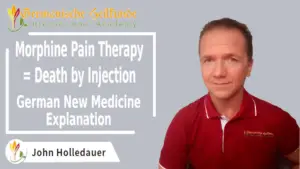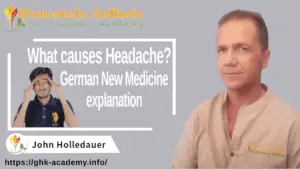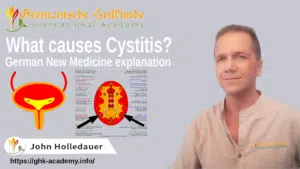
Pain is a difficult subject because one instinctively tries to avoid it and associates it with illness and death. But pain also has an important biological meaning.
Pain is not the beginning of the end. Understanding the meaning of pain is the best painkiller of all.
This short video will help you to understand pain.
This meaning Pain is not always a sign of the healing phase. In some special programs, pain is a symptom of the conflict-active phase.
In Germanische Heilkunde, you don’t have to memorize everything. There are common threads! Once you have recognized these common threads, you can deduce many things.
In glandular tissue, which is the yellow group, we have cell proliferation in the active phase and tuberculous degradation in the healing phase.
This is where the healing phase hurts!
The sore, middle ear infection, the healing phase of the choroidal melanoma, the intestinal colic, the appendix, etc …
In the glandular-like tissue, which is the yellow/orange striped group, we also have cell proliferation in the active phase and tuberculous degradation in the healing phase. In this case, the healing phase hurts, the pimple , the healing phase of mammary carcinoma, and the healing phase of pleura cancer.
The connective tissue, which is the orange group, necrotizes in the active phases, so it makes cell minus.
In the bone, this cell minus is also called osteolysis. Unfortunately, the active phase does not hurt here, so the process goes unnoticed as the holes in the bone or in the lymph node become larger and larger.
But the healing phase, on the other hand, is usually immediately noticeable after the conflict is resolved. The holes are filled again during the swelling, which hurts up to the crisis.
With the crisis, the swelling goes down, and so does the pain. And at the end of the healing phase, the tissue remains thicker than before. The healing phase hurts in the orange group.
It gets somewhat more complicated with the squamous epithelium. The squamous epithelium is the red group, it ulcerates in the active phase and is repaired in the healing phase under swelling, and the crisis here is always the absence.
Squamous epithelium is the developmentally youngest tissue, and Dr. Hamer thought that it sprouts from the sinuses, and lines the mouth and throat.
It migrates in via the pharynx and the small curvature in the stomach to the first section of the duodenum. Here this squamous epithelium then stops. But it also migrates about 12 cm up the rectum, the vagina, and the entire urinary tract.
When the ring structure of the thyroid gland was ruptured, these squamous organs were without nerve connections and had to be rewired with nerves.
Sensory-wise, these organs were connected to the outer skin.
Motor-wise, they had to be rewired through the spinal cord, which can be clearly seen in paraplegia. People with true paraplegia need diapers because they can’t hold feces or urine.
In the squamous epithelium, we have two patterns: the outer skin and gullet-mucous patterns.
The Outer-Skin-pattern is numb in the active phase and also hurts in the healing phase: this is the neurodermatitis, the fever blister, eczema, cystitis, the external hemorrhoids. So this is where the pain starts after conflict resolution.
On the other hand, the gullet-mucous pattern hurts in the active phase: the duodenal ulcer, the gastric ulcer, the esophagus, the ulcer of the oral mucous membrane, the hole in the tooth enamel (thus caries), angina pectoris – this is the active loss of territory conflict and very important: the periosteum – thus rheumatism.
If you solve the conflict here, the pain is gone. So when a person complains about a painful bladder infection, that is the outer-skin pattern, then you know he is in the healing phase.
If, on the other hand, he complains about a painful stomach ulcer, then this follows the gullet-mucous pattern. Then you know that he has not resolved his conflict; he is still in the conflict-active phase.
As mentioned before, the crisis in the squamous is always the absence. If the active phase is numb, the crisis is also sensory numb and without pain. However, the crisis is also painful if the active phase is painful.
In the outer-skin pattern, the crisis is numb: the neurodermatitis in the crisis is numb, as well as cystitis. On the other hand, one has violent pain in the crisis of a stomach ulcer. Likewise, the heart attack patient again has very severe angina during the crisis.
So, when the child complains of pain with caries, it may be the active phase or the crisis.
You see, in Germanische Heilkunde, you don’t have to learn everything by heart; you can deduce a lot of things once you have found these common threads.
If you, dear student, have understood this teaching, then you know why you have one symptom or another. And if you know why you have a certain symptom, then you also know what to do to get well again.
I hope you enjoy your continued study, and goodbye until the following video.










| Cookie | Duration | Description |
|---|---|---|
| cookielawinfo-checkbox-analytics | 11 months | This cookie is set by GDPR Cookie Consent plugin. The cookie is used to store the user consent for the cookies in the category "Analytics". |
| cookielawinfo-checkbox-functional | 11 months | The cookie is set by GDPR cookie consent to record the user consent for the cookies in the category "Functional". |
| cookielawinfo-checkbox-necessary | 11 months | This cookie is set by GDPR Cookie Consent plugin. The cookies is used to store the user consent for the cookies in the category "Necessary". |
| cookielawinfo-checkbox-others | 11 months | This cookie is set by GDPR Cookie Consent plugin. The cookie is used to store the user consent for the cookies in the category "Other. |
| cookielawinfo-checkbox-performance | 11 months | This cookie is set by GDPR Cookie Consent plugin. The cookie is used to store the user consent for the cookies in the category "Performance". |
| viewed_cookie_policy | 11 months | The cookie is set by the GDPR Cookie Consent plugin and is used to store whether or not user has consented to the use of cookies. It does not store any personal data. |
You’ll be informed by email when we post new articles and novelties. In every email there is a link to modify or cancel your subscription.